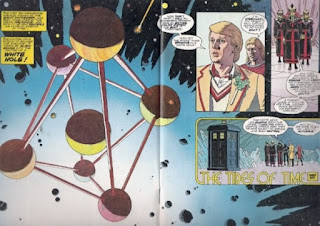The Tides of Time
is written by Steve Parkhouse with art by Dave Gibbons. It was released in Doctor Who Monthly issues
61-67 (January-July 1982) and is reprinted in its original form in Doctor Who: The Tides of Time by Panini
Books.
With the coming of the
Fifth Doctor to television and the comic strip, writer Steve Parkhouse decided
it was time to shift things into a new direction. For a new Doctor, it was decided to present a
debut story which could only be described as epic, with an issue length that
hadn’t been seen since Mills and Wagner’s final story, Doctor Who and the
Dogs of Doom, and a story that would take the Fifth Doctor throughout time
and space to stop an evil alien demon from taking over the universe. The premise of The Tides of Time is
one that involves the timeline collapsing due in part to the machinations of
Catavolcus in The Neutron Knights, summoning the demon Melanicus who has
managed to take over the Event Synthesizer, a science fiction style organ that
is responsible for the flowthrough of time, and is first shown playing the
chord progression for the Doctor Who theme. The Doctor is called upon by Rassilon, yes
that Rassilon, after at a game of cricket a grenade from just before World War
II nearly blows up the pitch. A medieval
knight, Sir Justin of Wells, finds his way to 1982 and teams up with the Doctor
to defeat the demon, travel to Gallifrey, and ensure that the timelines are
saved. This is a story that is
incredibly ambitious, more so than any of the longer stories by Mills and
Wagner. Mills and Wagner would usually
take a fairly simple premise and just allow it to tell itself over eight
issues, while Parkhouse’s plot is far more complex and reliant on a core cast
of characters with their own motivations.
Melanicus is perhaps the least
developed as a central villain who simply wants to take over the universe with
a plan that doesn’t actually get explained very well. He brings time together to destroy it and
create a white hole, which is meant to be the opposite of a black hole, and
somehow that will take down the Time Lords.
His design is excellent, making some interesting little twists on a
traditional demonic design, and the illusions he uses during the middle of the
story also helps with the trippy nature of bringing all of time together. Rassilon makes his first appearance in all of
Doctor Who here, essentially being portrayed as a godlike guardian
living inside the Matrix where the rest of the dead Time Lords’ consciousness
goes, another interesting idea which originates here, but would eventually be
used in the show itself, most obviously in The Name of the Doctor. While there will be some excellent
explorations of Rassilon and his less than stellar record on morality and
manipulation in the Doctor’s life, here he is essentially a revered religious
figure who is there to guide the Doctor through the adventure.
Like the introduction of
Sharon Davies as a companion for the Fourth Doctor, Parkhouse gives the Fifth
Doctor comic original companions here to flesh out his adventures. First is Sir Justin of Wells, a knight who
essentially represents the ideals of chivalry and actually makes a very good
foil to the Fifth Doctor. The Fifth
Doctor, until David Tennant took over the role in 2005, was perhaps the most
human Doctor and Sir Justin creates a very human companion to create a very nice
and smooth dynamic. This isn’t say the
abrasive relationship from Tegan or the student/teacher relationship of Nyssa,
but the Doctor taking someone who shares his ideals and trusts to do the right thing
on a noble quest to save the universe.
The other companion is Shayde, a being constructed to help the Doctor in
the defeat of Melanicus as his existence is expendable while the Doctor is not,
setting up what could have been a touching sacrifice, however the entire ending
of this story is one that hinges on the plan just blowing itself up because of how
unstable it is. This does mean that the climax
is perhaps too much of an anti-climax, but this TARDIS team was one that
clearly could have had staying power, with Shayde reappearing in future comics
though Sir Justin never reappeared after this story. Still, with seven issues a seven month run is
not a bad one for a companion, even if that comprises only one story. Parkhouse truly makes an epic, and Dave
Gibbons’ art, while criticized by Peter Davison for not capturing his license,
is once again a delight. This is also
the first story where any color art was done when printed in Doctor Who
Monthly, establishing this as a truly epic event as the magazine was still
printed in black and white until 2001, nearly 20 years after this story was
published. The colorist for the two page
spread opening the sixth issue of The Tides of Time is not known, but it
is an evocative image and makes things just pop out as a special story.
Overall, The Tides of
Time is a truly epic story which needed an extended issue count to really
tell and ushered in the new Doctor for the magazine incredibly well,
characterizing him incredibly close to how Davison would play the character
even if this story started releasing just after Castrovalva aired to debut
the Fifth Doctor. This may have a very
odd ending, and one that doesn’t exactly work, but it’s still very close to
perfection, bringing in a new, connected era for the Doctor Who Monthly
range and really starting the story arc of the Fifth Doctor comics. 9/10.

No comments:
Post a Comment